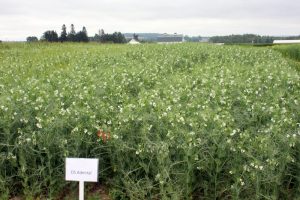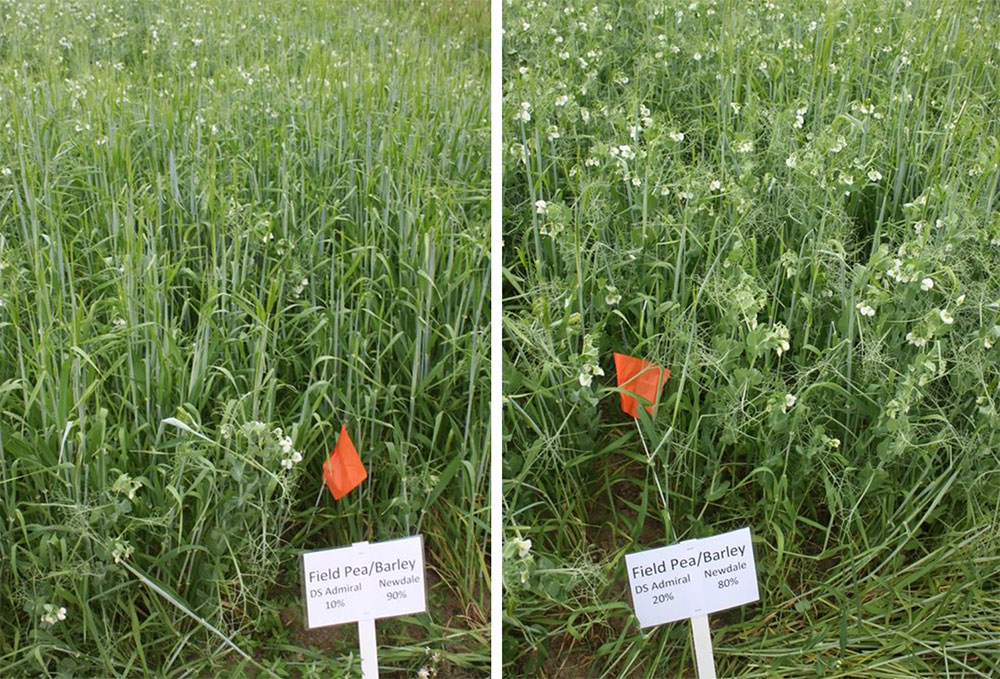2013 Intercropping Field Peas and Cereals
Field Pea Demonstration Trial 2013 Results
Tom Molloy and Ellen Mallory, University of Maine Cooperative Extension
Field Pea Demonstration Trial — 2013 Results (PDF)

Introduction
Organic field peas are of interest in Maine as a high protein feed source and a rotation crop for cereals. A trial was established at the University of Maine’s Aroostook Farm in Presque Isle in 2013 to demonstrate organic field pea production for grain. The variety DS Admiral was planted alone and in mixes with barley and oats. Funding for this trial was provided by Organic Valley and the Grantham Foundation.
Field Pea Types
The variety DS Admiral is a yellow cotyledon, determinant, semi-leafless variety that is suitable for grain production. Grain-type field peas tend to be determinant types that have a fixed flowering period and shorter vines (2-4 feet). DS Admiral is also one of the semi-leafless types with modified leaflets that act like tendrils. Both the shorter vine length and increased tendrils greatly improves the standability of determinant, semi-leafless peas making them much easier to dry down and harvest. In contrast, forage-type peas are indeterminate, have normal leaves, and produce vines up to six feet long. Field peas are also classified based on their cotyledon or seed color. Yellow and green types can be grown for either food or feed markets, depending on the variety. The DS Admiral for this trial was sourced from Johnny’s Selected Seeds.
Growing Peas with Cereals
Growing peas in mixes with cereals is commonly done for cover cropping or for forage production. In regions where peas are grown for grain, they are usually grown as a monocrop. However, it is thought that growing peas in mixes with cereals could help reduce lodging and weed pressure. Designing the right mix requires matching the pea and cereal varieties for maturity and mixing the seed at a ratio that benefits both crops. For instance, work done in Maritime Canada showed that going above 20% of peas in the seed mixture increases lodging potential (OACC interim report E2006-11).
Methods
In this trial, DS Admiral field peas, three varieties of barley, and one variety of oats were grown in monocrop and in mixtures (Tables 1 and 2). The barley varieties were Conlon, Newdale and Kawartha, and the oat variety was Colt. In addition, the barley/pea mixes were planted at two different mix ratios, one where the pea seed made up only 10% of the seeds planted and another where the pea seed made up 19% of the seeds planted. The Colt oat/pea mixture was planted with 21% peas in the mix.
The field where this demonstration took place had been in conventional potatoes the previous year. The soil type is Caribou gravely loam. Chicken manure was spread at a rate of approximately 3 tons per acre on May 13 and immediately incorporated with a disk harrow. Because peas can fix most of their own nitrogen, spreading manure ahead of field peas is not a recommend practice, but due to other experiments occurring in the same field, manure had to be spread uniformly throughout the field. Final seedbed preparation was done with a Vibrashank seedbed conditioner and planting occurred on May 14. Peas, barley, oats, and mixtures were seeded with an Almaco small-plot cone seeder with 6.5-inch row spacing. Plots were tine weeded on June 5 with a Lely weeder when the peas were approximately 3 inches tall. The plots were harvested on August 31 with a Wintersteiger small-plot combine.
Table 1. Seed characteristics and monocrop seeding rates.
| Crop | Variety | Germination (%) | Number of seeds/pound | Seeding rate (#/square foot) | Seeding rate (lbs/acre) |
|---|---|---|---|---|---|
| Field Pea | DS Admiral | 85 | 2,318 | 9 | 199 |
| Barley | Conlon | 97 | 12,077 | 33 | 121 |
| Barley | Newdale | 96 | 8,887 | 33 | 103 |
| Barley | Kawartha | 90 | 11,068 | 33 | 142 |
| Oat | Colt | 90 | 15,569 | 33 | 101 |
Table 2. Seeding rates of pea/cereal mixes.
| Varieties | Percentage of pea seed in the mix (%) |
Seeding rate (#/square foot) | Seeding rate (lbs/acre) | ||||
|---|---|---|---|---|---|---|---|
| Pea | Cereal | Mixture total | Pea | Cereal | Mixture total | ||
| DS Admiral/Conlon | 10 | 3 | 28 | 31 | 66 | 104 | 170 |
| DS Admiral/Newdale | 10 | 3 | 28 | 31 | 66 | 142 | 208 |
| DS Admiral/Kawartha | 10 | 3 | 28 | 31 | 66 | 122 | 188 |
| DS Admiral/Conlon | 19 | 6 | 23 | 29 | 123 | 86 | 209 |
| DS Admiral/Newdale | 19 | 6 | 23 | 29 | 123 | 119 | 242 |
| DS Admiral/Kawartha | 19 | 6 | 23 | 29 | 123 | 102 | 225 |
| DS Admiral/Colt | 21 | 4 | 14 | 18 | 82 | 43 | 125 |

Admiral pea grown with Newdale barley in a 10%/90% mix (left) and a 20%/80% mix (right). Photo by Ellen Mallory.
Results and Discussion
The results from this trial are from non-replicated demonstration plots, so this information should be used only for getting a general estimate of the potential for organic field pea production in northern Maine.
The yield of DS Admiral grown as a monocrop was quite good at 4,022 lbs/acre. The barley variety yields ranged between 1,940 and 2,407 lbs/acre and the oat yielded 3,161 lbs/acre when grown alone (Graph 1). The yields of the various cereal/pea mixes were greater than the cereals when grown alone, but similar to the monocrop pea.
Graph 2 shows the total yield of the mixes as well as the yield of the individual components of each mix. Increasing the amount of pea seed in the planted mix by 90% (from 10% to 19% of the mix) increased the portion of the pea grain in the harvested crop by about 70% with the Kawartha and Newdale barley varieties but only by 11% with Conlon. Peas made up 52-69% of the harvested grain at the higher pea mix and 30-62% at the lower rate. The Colt oat/pea mix had yields similar to the pea monocrop with the peas making up 66% of the harvested grain.


Summary
In this demonstration trial, the yield of the field pea variety grown alone was quite good and comparable to hard red spring wheat yields here in Maine. Mixing field peas with cereals did give an improvement in yield over the monocrop cereals, but the monocrop field peas still out yielded the pea/cereal mixes with the exception of the pea/oat mix. Lodging of the pea plots was noted throughout the field and could not be linked to any one seeding practice. Excessive rainfall and the use of manure as a fertility source could have exacerbated the lodging problem. Because peas are not as competitive with weeds as cereals, there still might be a system level benefit of growing peas in mixtures with cereals.
Additional Resources
For more information on grain pea varieties and production practices see the following publications.
- Field Pea Production, Bulletin A-1166, North Dakota State University. http://www.ag.ndsu.edu/pubs/plantsci/rowcrops/a1166.pdf
- North Dakota Dry Pea Variety Trial Results for 2013 and Selection Guide, NDSU. http://www.ag.ndsu.edu/pubs/plantsci/rowcrops/a1469_13.pdf
- Alternative Field Crops Manual, University of Wisconsin Extension. http://www.hort.purdue.edu/newcrop/AFCM/index.html
- Growing Field Peas in Montana, MT 9520, Montana State University Extension Service. http://www.msuextension.org/pspp/documents/GrowingDryPea.pdf
- Managing Field Peas Organically, Lakeview Organic Grain. http://www.lakevieworganicgrain.com/info_docs/managing%20peas%20organically.pdf
